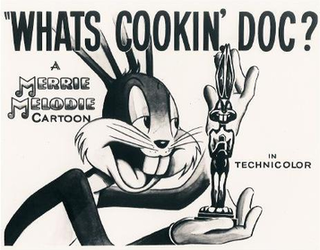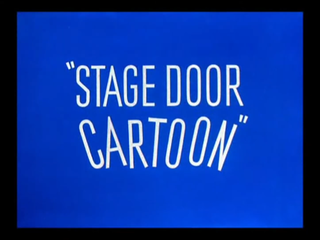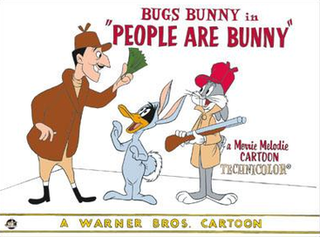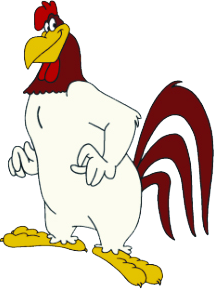
Bugs Bunny is a cartoon character created in the late 1930s at Warner Bros. Cartoons and voiced originally by Mel Blanc. Bugs is best known for his featured roles in the Looney Tunes and Merrie Melodies series of animated short films, produced by Warner Bros. Earlier iterations of the character first appeared in Ben Hardaway's Porky's Hare Hunt (1938) and subsequent shorts before Bugs's definitive characterization debuted in Tex Avery's A Wild Hare (1940). Bob Givens, Chuck Jones, and Robert McKimson are credited for defining Bugs's design.

Yosemite Sam is a cartoon character in the Looney Tunes and Merrie Melodies series of short films produced by Warner Bros. His name is taken from Yosemite National Park in California. He is an adversary of Bugs Bunny and his archenemy alongside Elmer Fudd. He is commonly depicted as a mean-spirited and extremely aggressive, gunslinging outlaw or cowboy with a hair-trigger temper and an intense hatred of rabbits, Bugs in particular. In cartoons with non-Western themes, he uses various aliases, including "Chilkoot Sam" and "Square-deal Sam" in 14 Carrot Rabbit, "Riff Raff Sam" in Sahara Hare, "Sam Schultz" in Big House Bunny, "Seagoin' Sam" in Buccaneer Bunny, "Shanghai Sam" in Mutiny on the Bunny, "Von Schamm the Hessian" in Bunker Hill Bunny, "Baron Sam von Schpamm" in Dumb Patrol, and many others. During the golden age of American animation, Yosemite Sam appeared as antagonist in 33 animated shorts made between 1945 and 1964.

Super-Rabbit is a 1943 Warner Bros. cartoon starring Bugs Bunny. The cartoon is a parody of the popular comic book and radio character Superman by DC Comics. Super-Rabbit was the 16th Bugs Bunny entry, and the 47th directed by Chuck Jones.

Elmer's Candid Camera is a 1940 Warner Bros. Merrie Melodies cartoon short directed by Chuck Jones. The short was released on March 2, 1940, and features Elmer Fudd and an early Bugs Bunny prototype.

Ballot Box Bunny is a 1951 Warner Bros. Merrie Melodies theatrical cartoon short directed by Friz Freleng and written by Warren Foster. The cartoon was released on October 6, 1951, and features Bugs Bunny and Yosemite Sam.

Hair-Raising Hare is a Warner Bros. Merrie Melodies cartoon, released on May 25, 1946. It was directed by Chuck Jones and written by Tedd Pierce. It stars Bugs Bunny and features the first appearance of Chuck Jones' orange monster character "Gossamer".

Little Red Riding Rabbit is a 1944 Warner Bros. Merrie Melodies cartoon, directed by Friz Freleng, and starring Bugs Bunny. It is a sendup of the "Little Red Riding Hood" story, and is the first time in which Mel Blanc receives a voice credit.

Bunker Hill Bunny is a 1950 Warner Bros. Merrie Melodies theatrical cartoon short directed by Friz Freleng and written by Tedd Pierce. The short was released on September 23, 1950 and stars Bugs Bunny and Yosemite Sam as a Hessian mercenary in the American Revolution.

Hare Remover is a Merrie Melodies cartoon starring Bugs Bunny and Elmer Fudd, released in 1946. The film was the second Bugs Bunny cartoon to be directed by Frank Tashlin, the first being The Unruly Hare (1945). It was also the last short Tashlin directed before leaving Warner Bros. in 1944 to direct live-action films. His animation unit was handed over to Robert McKimson upon his departure.

What's Cookin' Doc? is a 1943-produced, 1944 Warner Bros. cartoon in the Merrie Melodies series, directed by Bob Clampett, and stars Bugs Bunny. The short was also written by Michael Sasanoff, and was animated by Robert McKimson, along with uncredited work by Rod Scribner, Phil Monroe and Virgil Ross. The film was released on January 8, 1944.

Buccaneer Bunny is a 1948 Looney Tunes cartoon directed by Friz Freleng. The short was released on May 8, 1948, and features Bugs Bunny and Yosemite Sam.

Stage Door Cartoon is a 1944 Merrie Melodies cartoon directed by Friz Freleng. The short was released on December 30, 1944, and features Bugs Bunny and Elmer Fudd.

(Blooper) Bunny is a Merrie Melodies animated short film directed by Greg Ford and Terry Lennon, with music by George Daugherty, produced in 1991 by Warner Bros. Animation. Featuring the voice talents of Jeff Bergman, Gordon Hunt, and Russell Calabrese, the short is a parody of some of the specials produced for Bugs Bunny's 50th anniversary the previous year. The short never received its intended theatrical release and was shelved for six years. It was finally given a television premiere on June 13, 1997, after Cartoon Network discovered the film sitting unseen in the vaults. It is featured on the Looney Tunes Golden Collection: Volume 1 as of 2003.
The Bugs Bunny Mystery Special is an animated television special that was broadcast on CBS October 15, 1980. Presented by Porky Pig as an Alfred Hitchcock-style whodunit, the plot is modeled after those of North by Northwest and The Fugitive.

A Pest in the House is a Merrie Melodies animated short film released on August 2, 1947. It is directed by Chuck Jones and stars the characters of Daffy Duck and Elmer Fudd.

People Are Bunny is a 1959 Warner Bros. Merrie Melodies cartoon, directed by Robert McKimson The short was released on December 19, 1959, and stars Bugs Bunny and Daffy Duck.

Foghorn Leghorn is an anthropomorphic rooster who appears in Looney Tunes and Merrie Melodies cartoons and films from Warner Bros. Animation. He was created by Robert McKimson, and starred in 29 cartoons from 1946 to 1964 in the golden age of American animation. All 29 of these cartoons were directed by McKimson.

Elmer J. Fudd is an animated cartoon character in the Warner Bros. Looney Tunes/Merrie Melodies series and the archenemy of Bugs Bunny. His aim is to hunt Bugs, but he usually ends up seriously injuring himself and other antagonizing characters. He speaks in an unusual way, replacing his Rs and Ls with Ws, so he often refers to Bugs Bunny as a "scwewy" (screwy) or "wascawwy (rascally) wabbit". Elmer's signature catchphrase is, "Shhh. Be vewy vewy quiet, I'm hunting wabbits", as well as his trademark laughter.

Foxy by Proxy is a 1952 Merrie Melodies cartoon directed by Friz Freleng. The short was released on February 23, 1952, and features Bugs Bunny and Willoughby the Dog, in the latter's last appearance. Mel Blanc voices Bugs Bunny, while an uncredited Stan Freberg voices Willoughby and one of the dogs that talks in the short. This cartoon is considered a remake to Of Fox and Hounds from 1940; in fact, the opening sequence was "borrowed" directly from the original.
Napoleon Bunny-Part is a 1956 Warner Bros. Merrie Melodies cartoon, directed by Friz Freleng. The shot was released on June 16, 1956, and stars Bugs Bunny. In this film, Bugs Bunny's opponent is Napoleon. Bugs disguise himself as Empress Joséphine. It is a typical use of cross-dressing in Bugs' film appearances.


















